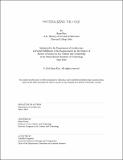| dc.contributor.advisor | Renée Green. | en_US |
| dc.contributor.author | Kuo, Ryan, S.M. Massachusetts Institute of Technology | en_US |
| dc.contributor.other | Massachusetts Institute of Technology. Department of Architecture. | en_US |
| dc.date.accessioned | 2014-11-04T20:28:39Z | |
| dc.date.available | 2014-11-04T20:28:39Z | |
| dc.date.copyright | 2014 | en_US |
| dc.date.issued | 2014 | en_US |
| dc.identifier.uri | http://hdl.handle.net/1721.1/91302 | |
| dc.description | Thesis: S.M. in Art, Culture and Technology, Massachusetts Institute of Technology, Department of Architecture, 2014. | en_US |
| dc.description | This electronic version was submitted by the student author. The certified thesis is available in the Institute Archives and Special Collections. | en_US |
| dc.description | Cataloged from student-submitted PDF version of thesis. | en_US |
| dc.description | Includes bibliographical references (pages 62-65). | en_US |
| dc.description.abstract | This thesis concerns the body as it faces the computer. While it is informed by theories of embodiment, it argues against a retreat to the "human" in the face of new sensations that may result from the body's willing incorporation into the computer as an avatar. At the same time, the processes of self-virtualization enabled by computation are subject to question. Extending from the author's practice as an artist working in interactive media, digital video, sound, and writing, this work posits that both human and computer compete for agency in the active construction of meaning. Rather than locate this construction in either a perceptual or an algorithmic process, the encounter with the computer is described as a vibration. This allows both human and computer to be considered as affective bodies prior to signification. The vibration between these bodies is a form of movement opened by interrupting the process of signification that occurs when the computer renders code; the user responds to the computer's output; and rendering, response, and interaction are all read discursively. Both interruption and vibration are theorized here in relation to Merleau-Ponty, Virilio, Lyotard, Goodman, Hansen, Barthes, Beckett, Cézanne, Plato, and other theorists and practitioners. | en_US |
| dc.description.statementofresponsibility | by Ryan Kuo. | en_US |
| dc.format.extent | 65 pages | en_US |
| dc.language.iso | eng | en_US |
| dc.publisher | Massachusetts Institute of Technology | en_US |
| dc.rights | M.I.T. theses are protected by copyright. They may be viewed from this source for any purpose, but reproduction or distribution in any format is prohibited without written permission. See provided URL for inquiries about permission. | en_US |
| dc.rights.uri | http://dspace.mit.edu/handle/1721.1/7582 | en_US |
| dc.subject | Architecture. | en_US |
| dc.title | Materializing the hole | en_US |
| dc.type | Thesis | en_US |
| dc.description.degree | S.M. in Art, Culture and Technology | en_US |
| dc.contributor.department | Massachusetts Institute of Technology. Department of Architecture | |
| dc.identifier.oclc | 893559438 | en_US |
